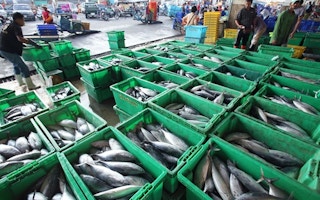Severe global warming – a rise in annual average global temperatures driven by ever-increasing burning of fossil fuels – could force change in up to 70 per cent of the ocean ecosystems, according to new research.
Even moderate global warming, in which greenhouse gas emissions stabilise in the next 25 years, could trigger changes three times greater than any seen in oceans over the last 50 years.
Marine biologist Grégory Beaugrand, of the University of Science and Technology at Lille in France, and colleagues report in Nature Climate Change that they used a new approach to calculate the overall pattern of winners and losers in tomorrow’s world, as carbon dioxide levels in the atmosphere soar and climates change.
They found that tropic and warm water regions would become poorer in living things, with biodiversity decreased. Some species would become extinct, some might adapt, and others would migrate.
Higher latitudes, however, would see a greater mix of living creatures – an increase in diversity of up to 300 per cent – as species migrated north or south towards the polar regions in response to sea temperature change.
Ground-breaking model
The scientists started from the basis that − local variations in fishing, hunting, food supply and water chemistry aside − what mattered in the marine world was mostly temperature.
“We developed a ground-breaking new model for how biodiversity is arranged in the oceans and tested its accuracy using real world examples from plankton to whales − in fact the smallest of sea creatures to the largest,” Dr Beaugrand says.
“The main environmental variable in our model influencing where species like to live is temperature. We demonstrated that our model can reconstruct accurately patterns of marine biodiversity, and then we used it to see how biodiversity may reorganise in response to four different levels of global warming.”
The scientists used the past as a guide to the present and to future change. They compared the distribution of species now with what the fossil record showed for the mid-Pliocene epoch about three million years ago, when the world was 3°C warmer than it is now, and during the last glacial maximum 20,000 years ago, when the world was 4°C to 5°C cooler.
“
The main environmental variable in our model influencing where species like to live is temperature. We demonstrated that our model can reconstruct accurately patterns of marine biodiversity, and then we used it to see how biodiversity may reorganise in response to four different levels of global warming.
Grégory Beaugrand, marine biologist, University of Science and Technology at Lille
The researchers from France, Britain and Monaco have once again confirmed that the warmer the planet, the greater the potential change. But most previous research has focused on the impact of climate change on the terrestrial world. In fact, Earth is 70 per cent ocean, and 70 per cent of the planet’s people live within 60km of the shoreline.
Humans survive on the sea’s productivity, landing 80 million tonnes of fish each year, and the oceans play a decisive role in the regulation of the planetary climate.
The oceans have already begun to respond to climate change, as familiar species move north or dive deeper in search of the ideal temperatures in which to thrive, and invasive species eat away at long-established ecosystems.
But it is harder to predict quite how nature rebalances itself in oceans that will also be changed by increasing acidity and pollution.
“Any reorganisation of marine biodiversity will affect us in some way,” Dr Beaugrand says. “Some individual changes may be good, and some may be bad. For example, harmful algal blooms may increase in some places and decrease in others.
Function and productivity
“However, together, any changes in biodiversity will inevitably affect interactions among species, and consequently how the ecosystem functions and how productive it is, which are important aspects to understand and predict.”
If the world’s nations keep to the commitment to limit global warming to below 2°C, only about 15 per cent of the ocean would undergo changes greater than happened over the last 20,000 years, and only 25 per cent would see a change greater than since the mid-Pliocene more than three million years ago.
However, at 2°C, between 37 per cent and 4 6per cent of the oceans would experience changes in biodiversity, and at higher levels these changes could range from 50 per cent to 70 per cent, the scientists say.
If emissions peak in the next five years and begin to decline, any biological changes might not be very different from existing patterns of variability seen in the last 50 years. But change is on the way.
“Our results show that climate change may rapidly reorganise marine biodiversity over large oceanic regions, and that the intensity of this reorganisation will depend, unsurprisingly, on the magnitude of warming,” the authors conclude.

















